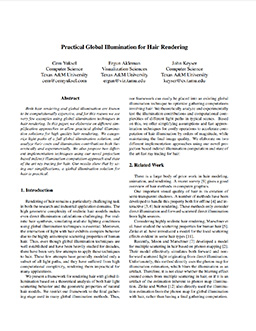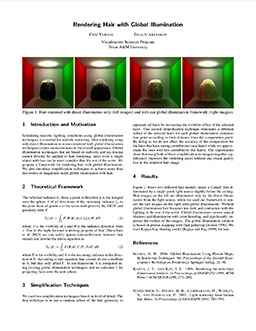Hair Rendering with Global Illumination

This image shows the effect of global illumination on hair.
Color bleeding can be seen on either side of the hair model,
and the overall illumination of hair makes it fit to its environment.
Abstract
Both hair rendering and global illumination are known to be computationally expensive, and for this reason we see very few examples using global illumination techniques in hair rendering. However, hair rendering using only direct illumination in scenes rendered by global illumination methods creates inconsistencies in the overall appearance. The goal of this project is to achieve practical hair rendering with global illumination using techniques specialized for hair, and propose solutions for hair rendering with global illumination to make it affordable for industrial applications. Both ray tracing and projection based alternative solutions are explored, considering and categorizing different light paths that lead to a complete global illumination solution. The preliminary results of this project were presented in SIGGRAPH 2005 as a sketch, and SIGGRAPH 2006 as a poster.
Images
| No global illumination on hair | No hair self-shadowing |
 |
 |
The image on the left is rendered without any global illumination on hair. Notice how the illumination of hair contradicts with the rest of the scene. The image on the right is rendered using global illumination, but not including hair strands in global illumination computation, thus ignoring self-shadowing between hair strands.

This is a close-up image of the same Cornell Box scene with a full global illumination solution
including inter-reflections between hair strands.

Here is a hairy teapot illuminated by a uniform skylight.


These are some of the early results.
In these images the illumination comes from high dynamic range images
at the background.
Publications



